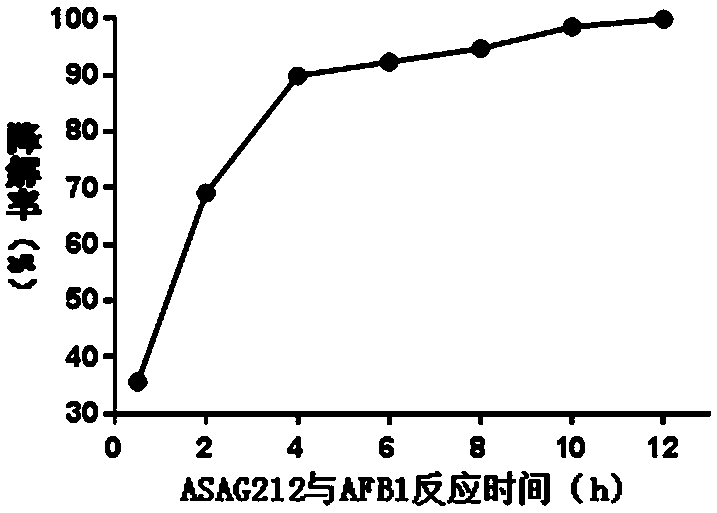Bacillus subtilis for degrading aflatoxin and application thereof
A technology of Bacillus subtilis and aflatoxin, applied in the direction of bacteria, microorganism-based methods, microorganisms, etc., can solve the problems of long degradation time and incomplete degradation degradation effect, so as to improve economic benefits, solve pollution problems, and strains safe effect
- Summary
- Abstract
- Description
- Claims
- Application Information
AI Technical Summary
Problems solved by technology
Method used
Image
Examples
Embodiment 1
[0032] Example 1 Isolation and identification of Bacillus subtilis ASAG212 that degrades AF
[0033] 1. Isolation of bacteria
[0034] (1) Multiple soil samples were randomly collected from grain planting areas in Xinzhou, Shanxi Province, and placed in ziplock bags, and the collection name, location, time and other information were indicated. Dilute 1 g of soil sample in 10 mL of sterile distilled water to prepare soil suspension, and use the concentration gradient method to gradually dilute 10, 100, 1000 and 1000 times.
[0035] (2) Spread soil sample suspensions diluted in different concentrations on LB solid plates and incubate at 37°C for 36 hours. , pick strains with different morphological features, colors, and sizes on the plate for plate streak purification, then perform AF degradation test on the purified strains, and analyze the strain with the highest degradation efficiency, the strain number is ASAG212.
[0036] 2. Bacteria identification
[0037] (1) Strain ...
Embodiment 2
[0065] Example 2 Degradation of AF by Bacillus subtilis ASAG212
[0066] 1. AF determination method
[0067] AF was detected by high performance liquid chromatography under the following conditions, Agilent C 18 Column (4.6 mm×150 mm×5 μm); mobile phase: methanol:water (50:50); flow rate: 1.0 mL / min; column temperature: 35˚C; detection wavelength: λex=360 nm, λem=440 nm ;Injection volume: 20 μL. The AF content was obtained by comparing the peak area with the standard curve.
[0068] 2. Degradation of AF by Bacillus subtilis ASAG212
[0069] (1) Inoculate 1 mL of preserved Bacillus subtilis ASAG212 into 50 mL of sterilized LB medium (10 g of tryptone, 5 g of yeast extract powder, 10 g of sodium chloride, 1000 mL of distilled water, pH 7.2-7.6) at 37 After culturing at 160 rpm for 18 h (OD value 0.8), take 900 µL of fermentation broth (concentration of 10 9 CFU / mL) with 100 µL AFB 1 standard mix to make the AFB 1 The final concentration of the standard is 10 μg / mL; at t...
Embodiment 3
[0076] Example 3 Degradation of AFB by Bacillus subtilis ASAG212 1 Product Safety Test
[0077] The TA98 standard strain (Moltox Company, USA) was activated, and TA98 was inoculated into 5 mL of sterilized broth medium, and cultured at 37°C, 150 r / min for 10 h for later use (cultivated in the dark). TA98 has undergone strain identification. These include: identification of histidine deficiency, identification of lipopolysaccharide barrier deficiency, identification of ampicillin resistance, identification of tetracycline resistance, UV-sensitivity properties and spontaneous back-change assay.
[0078] Divide 2.0 mL of the top layer agar medium containing 0.5 mmol / L histidine-0.5 mmol / L biotin solution into test tubes, incubate in a 45˚C water bath, and then add 0.1 mL of 0 h control group (900 µL PBS+100 µL 10 µg / mL AFB 1 reaction 0 h), 4 h control group (900µL PBS+100µL 10 μg / mL AFB 1 reaction for 4 h), 0 h degradation solution (900 µL Bacillus subtilis ASAG212 fermentati...
PUM
 Login to View More
Login to View More Abstract
Description
Claims
Application Information
 Login to View More
Login to View More - R&D
- Intellectual Property
- Life Sciences
- Materials
- Tech Scout
- Unparalleled Data Quality
- Higher Quality Content
- 60% Fewer Hallucinations
Browse by: Latest US Patents, China's latest patents, Technical Efficacy Thesaurus, Application Domain, Technology Topic, Popular Technical Reports.
© 2025 PatSnap. All rights reserved.Legal|Privacy policy|Modern Slavery Act Transparency Statement|Sitemap|About US| Contact US: help@patsnap.com

